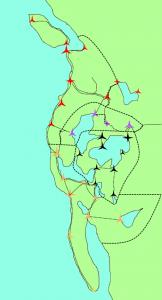Sorta inspired by this.
The Scablands Map
Description: there are three versions of the Scablands Map. First is what appears to be the original, which appears to been a thin slab of slate with numerous scratchings and markings on it. Unfortunately, about thirty percent of that Map is missing, and the rest was carefully broken into numerous pieces. The second Map appears to have been drawn on vellum some time around the beginning of the 17th Century AD, probably by Spanish monks. That Map is intact, and is stored in a wooden case with extensive scorch damage. And the third map is dated 1937, and is a product of the WPA’s Federal Art Project. It is reproduced below:

The artist in question — Hannah Anderson — went on to have a mildly successful career as a draftsman and local artist; she died in 1978 of natural causes, and left behind no explanation as to why she was assigned to this project. Or, in fact, what the project was at all. It’s fairly obviously a map of what looks to be the West Coast of the United States, only with considerably more wetlands (roughly consistent with existing research of prehistoric conditions in North America) and what appear to be markings for towns and roads. Which is nonsense, of course. If there were ever civilizations on the West Coast that were on the level of the Toltecs or Sumerians, there would also be evidence of that.
Then again, maybe the evidence is not being dug up for a reason. A thorough search of the history of archeological digs in the Western United States will quickly confirm that the areas marked on the Scablands Map have a much higher than average tendency to be abruptly canceled, never formally completed, or just be suspiciously bland. The archeologists on those projects also have a tendency to end up taking jobs with state or federal government, whereupon they more or less professionally disappear.
Note that they don’t disappear disappear. They can easily be found. They’re just not publishing papers, writing books, or teaching classes. And none of them seem particularly upset about it, either.
